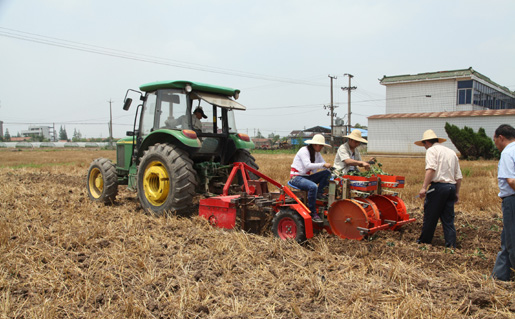Sweet Potato Combined Transplanter Newly Developed
2014-12-29

Recently, the sweet potato research team of Nanjing Research Institute for Agricultural Mechanization (NIAM) and the cooperative enterprise jointly developed 2ZFG-2 sweet potato combined transplanter. The transplanter which matched with 75~110 horsepower tractor can complete rotary tillage, ridging, stubble breaking, transplanting and reshaping operations at one time. It provides solid foundation to achieve full mechanization in sweet potato farming.
According to the introduction, sweet potato is usually planted in the high ridge (ridge height 25 ~ 30 cm, ridge distance 80 ~ 90cm). Because of its special physiological characteristics, the form that bare-root transplanting is used in sweet potato and the bare-root is sheared (pulled) before transplanting. Because of the restriction of technology that separates seedlings, nowadays fully automatic transplanting can’t be achieved all over the world. For Rotary tillage, soil preparation and ridging should be done at first when mechanical transplanting begins, then transplanter begins working towed by tractor. But as a result, it is difficult to match the tractor wheel distance and ridge distance. Ridge is easy to break when tractor wheels go in ditch, and it has high requirements for tractor size and driver. The planting process is complicated, the frequency of tractor works in field is high, and the cost of energy consumption and human resources is high. The top of the ridge is easily crushed or damaged by transplanter in the planting process in some kind of sand soil. In order to avoid affecting the growth and yield later, it needs to be reshaped again by manual.